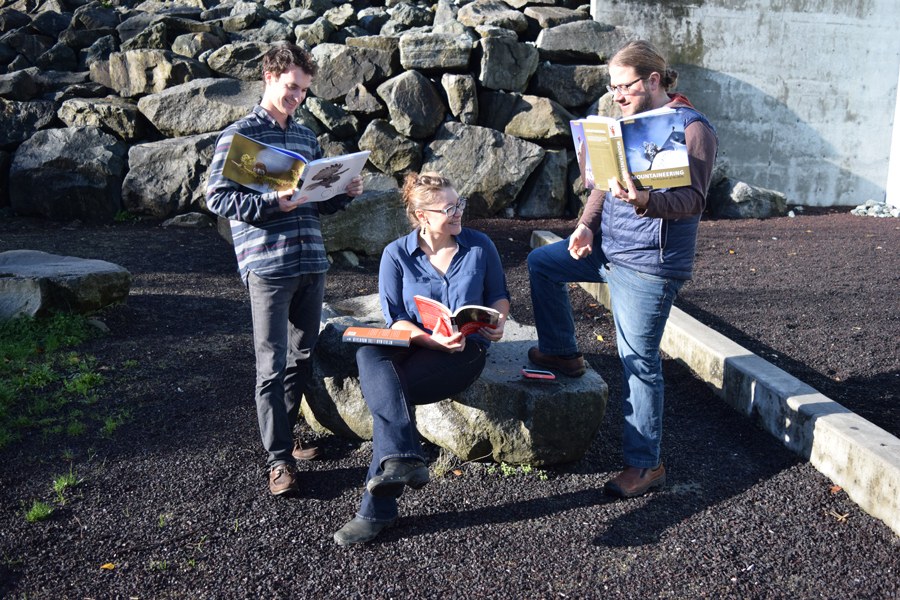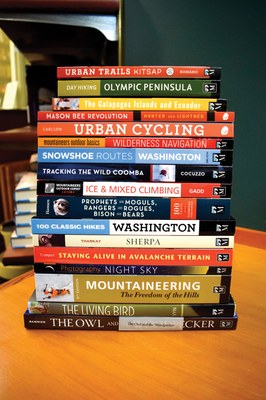
by Leone Kraus, Mountaineers Corporate and Foundation Relations manager
In 2007, I was working for The Washington Post and Slate magazine in New York City. My role was to support the sales team in developing media plans and executing digital media campaigns across our publishing platforms: The Washington Post, Slate, Newsweek and Budget Travel. I worked for The Washington Post for about six years, during which time I watched the decline of print newspaper subscriptions as the ascendancy of online media, tablets and smartphones took hold. I experienced first-hand how digital devices altered the world of print publishing.
Nearly a decade later, I now live in Seattle and work for The Mountaineers. When I first applied for my role at The Mountaineers, it wasn’t entirely clear from the job description that I’d be back in publishing. It wasn’t until my second interview, which included Helen Cherullo, publisher of Mountaineers Books, that I understood the breadth of the role I was taking on. Not only was I going to be working for a nonprofit, but I was going to be working for a nonprofit publisher. I was excited for the challenge of communicating to our readers and members why philanthropic support is critical to Mountaineers Books’ mission — which is to publish books that prioritize meaningful, quality content, while educating about mountaineering history, human-powered recreation, conservation and sustainable practice.
History and Mission Make for a Distinct Publisher
Mountaineers Books sprang to life in 1960 with the initial publication of Mountaineering: The Freedom of the Hills, which was written entirely by Mountaineers volunteers. Similar to the volunteer-led programs and courses offered under our programs division, for its first 18 years of existence, the publishing division was also volunteer-led. The Mountaineers Books catalog from this time had nearly 60 books listed and sold nationally, with authors and photographers paid royalties for their efforts.
By 1978, the success from Freedom and other titles, including the 100 Hikes series which launched in 1966 and the first Cascade Alpine Guide in 1973, allowed the organization to bring on professional paid publishing staff to lead the division. For nearly 30 years, then, Mountaineers Books thrived, publishing hundreds of books to inspire people to explore, recreate and conserve the great outdoors.
Today, the eighth edition of Freedom of the Hills is available in various languages in 15 countries, with a forthcoming new ninth edition in the final stages of editing. Mountaineers Books publishes roughly 35 new titles each year and has launched two imprints; Skipstone and Braided River allow us to focus in on sustainable living and conservation, respectively. A full-time staff of 20 publishing professionals spans across acquisitions, editorial, design, production, sales, marketing, publicity, and distribution – something that may have felt unimaginable back in 1960.
Mountaineers Books stands out from other outdoor publishers because of our ability to publish titles that support our organization’s mission of enriching lives by inspiring people to get outdoors. While other outdoor publishers make decisions based solely on economics — “will this book make money?” — we ask questions like, “Will this book be a catalyst and provide a strong lifelong bond to nature? With this book, will our readers learn skills and go places that leave them challenged and more rooted to our community?”

Are Print Books Still Relevant?
While at The Washington Post and Slate, I worked on the digital team, requiring me to be aware of trends in online journalism, including video, podcasts, click-rates of various advertisements to determine effectiveness and how much time a user spent on a screen. (Yes, you can measure this.) Working in print publishing is new to me but the role of working with editorial, production, and sales is not, so I had a good leg up in this new role.
As a leading independent publisher of outdoor content, we closely follow trends in how people consume content and how stories can move people to take action. In the past decade, digital devices have significantly altered the publishing space. In fact, I remember vividly the first time I held a first-gen iPhone, which was in the back of a taxi in New York City. At the time, I had no idea how quickly these innovations would alter the publishing world.
The end of the book had arrived — or so it seemed when reading online media outlets over the last ten years. And yet, a 2016 Pew Research study found that 73% of Americans have read a book in the past year and 65% of them chose to read a print book over a digital one. Related studies found that when people read printed materials, they are more likely to grasp and retain the information better than those who read the same content on digital devices.
Ann Mangen, a professional researcher who specializes in looking at how various technological devices affect one’s ability to comprehend what he or she is reading, found in a 2013 study that comprehension of reading differed from those who read online and those who read in print. An article published by the International Journal of Educational Research, titled “Reading Linear Texts on Paper Versus Computer Screen: Effects on Reading Comprehension,” lays out the detail of this study. In short, Mangen took a group of 72 10th graders who were given a 1,500 word narrative — about three pages. Youth were split into two groups; one group read the text in print and the other group read the same text in an online PDF. When done, students took a test consisting of multiple choice and short answer questions. The study found that those who read the text in print performed better than those who read the same text online.
Several factors affect the difference in performance; when people read print books their minds are able to create mental maps of where they are in the text through spatial reasoning, where as those who read online simply scroll and aren’t able to easily generate a frame of reference for where they are in the text. Other studies have found that when people read text online, they are distracted by the scroll or often click away from the content to look up something else, diverting them from the piece that they were previously reading. (Have you looked at your phone yet while reading this print edition of Mountaineer?)
Learning Proves to Be Fun (and Fuels our Economy)
People love to learn. Another 2016 study from Pew Research found that 74% of adults identify as personal learners; individuals who participate in one activity per year to learn something that interests them. Of these, 58% said they read a publication like a book or magazine to acquire new skills. Couple this data with the significant growth in the outdoor recreation economy: according to a 2016 report from the Outdoor Industry Association, more than 140 million Americans have made outdoor recreation a priority in their lives, putting $646 billion dollars into the economy through the purchase of gear, outdoor books, equipment, park staff and other related expenses like campground fees and souvenirs.
Of the 700 books in the Mountaineers Books catalog, more than 325 focus specifically on where-to and how-to instruction across various outdoor activities like hiking, climbing, kayaking, gardening and cycling. Our guidebooks feed the information desires of these personal learners and inspire them to get outside. When you consider the reading data referenced above, it seems clear that more people are turning to our print books to learn how to engage in new outdoor activities safely and responsibly than any other format, although many of our titles are also available as an ebook. Further, our where-to and how-to books are designed to be informative and visually engaging — giving people the information they need in a clear, attractive way. Given that outdoor recreation is only growing, the Mountaineers Books library of titles is more relevant than ever before.
Innovation and a Mission-Driven Focus
In 2011, The Mountaineers became a 501(c)(3) nonprofit organization, in the process making Mountaineers Books a nonprofit publisher. A year into my role here, I have come to realize many in the Mountaineers community are unaware of the strength this brings to our publishing division. Our revenue model is now similar to that of PBS or NPR, which rely on advertising support, membership dues as well as philanthropic support to fulfill their respective missions. Book sales make up roughly 85% of Mountaineers Books’ operating budget, and as a nonprofit publisher, we augment our sales by applying for grants and attracting corporate and private support from those invested in our mission.
Through philanthropic support, Mountaineers Books was able to adapt more quickly to the changing publishing landscape, and now it is allowing us to innovate within it. In 2003 we published Seasons of Life and Land, a photographic documentation of the biodiversity and indigenous cultures of the Arctic National Wildlife Refuge by photographer Subhankar Banerjee and foreword by former president, Jimmy Carter. Before becoming a nonprofit publisher, Mountaineers Books saw what was possible through philanthropic support, which funded fieldwork, partnerships with other grassroots organizations, public events, and museum exhibits — all of which leveraged the Seasons book in an authentic effort to achieve tangible conservation goals.
Mountaineers Books also turned to philanthropic support to supplement what couldn’t be achieved through book sales alone. Other publishers have largely abandoned the mountaineering history subject area, seeing it as “too niche,” except for a handful of mainstream titles. We consider publishing mountaineering literature that is core to our mission and serves the climbing and mountaineering community. (Side note: we highlighted Mountaineers Books donor Bill Buxton in the Fall 2016 issue of Mountaineer, whose generous donation allowed us to translate and publish Sherpa: The Memoir of Ang Tharkay in our Legends and Lore Series of mountaineering classics.)
Even with the advent and success of our ebook editions — which do appeal to some readers and ensure a title’s long-term relevancy — print books remain the fundamental revenue stream for Mountaineers Books by all significant measures. Of the 700 titles in the catalog, roughly 300 are also available as an ebook — but ebooks only comprise about 6% of our total revenue. More impactful for the digital age and outdoor education is eLearning: the entire organization invested in eLearning last year as a way to deliver instruction to students via the flexibility of an online platform, with Mountaineers Books leading the effort.

Inspiring Adventures
Mountaineers Books titles inspire adventures. Our guidebooks get used, marked up, and annotated by aspiring climbers. Our conservation photography titles have reached the hands of presidents and helped to preserve public lands and establish national parks. There is nothing quite like Mountaineers Books within any other outdoor organization, with its mission-driven focus, creativity, programs and impact. Through philanthropic support, Mountaineers Books will be able to continue to publish and promote books and authors that speak to the heart of the mission of The Mountaineers — inspiring even more people to get outdoors and to care for our natural lands.
While at Slate, I wondered when I would be able to work for a mission-driven organization, which is what led me to my next role working for Blue State Digital, a digital communications firm that specialized in fundraising for nonprofits and political candidates. As it turned out, The Mountaineers was already a part of my life back in Brooklyn. For years, a mountaineering book that my wife owned, called Freedom of the Hills sat on our bookshelf. I groaned about packing it each time we lugged this thick book from one abode to another in Brooklyn, and then across the country to Seattle. But I’m glad we kept it — not only for the content, but because it was a sign for what was to come in my life.
 3519b6fe382746fbb24aac803264f537
3519b6fe382746fbb24aac803264f537